/
SEO
/
0 min read
SEO: The Complete Guide to Search Engine Optimization
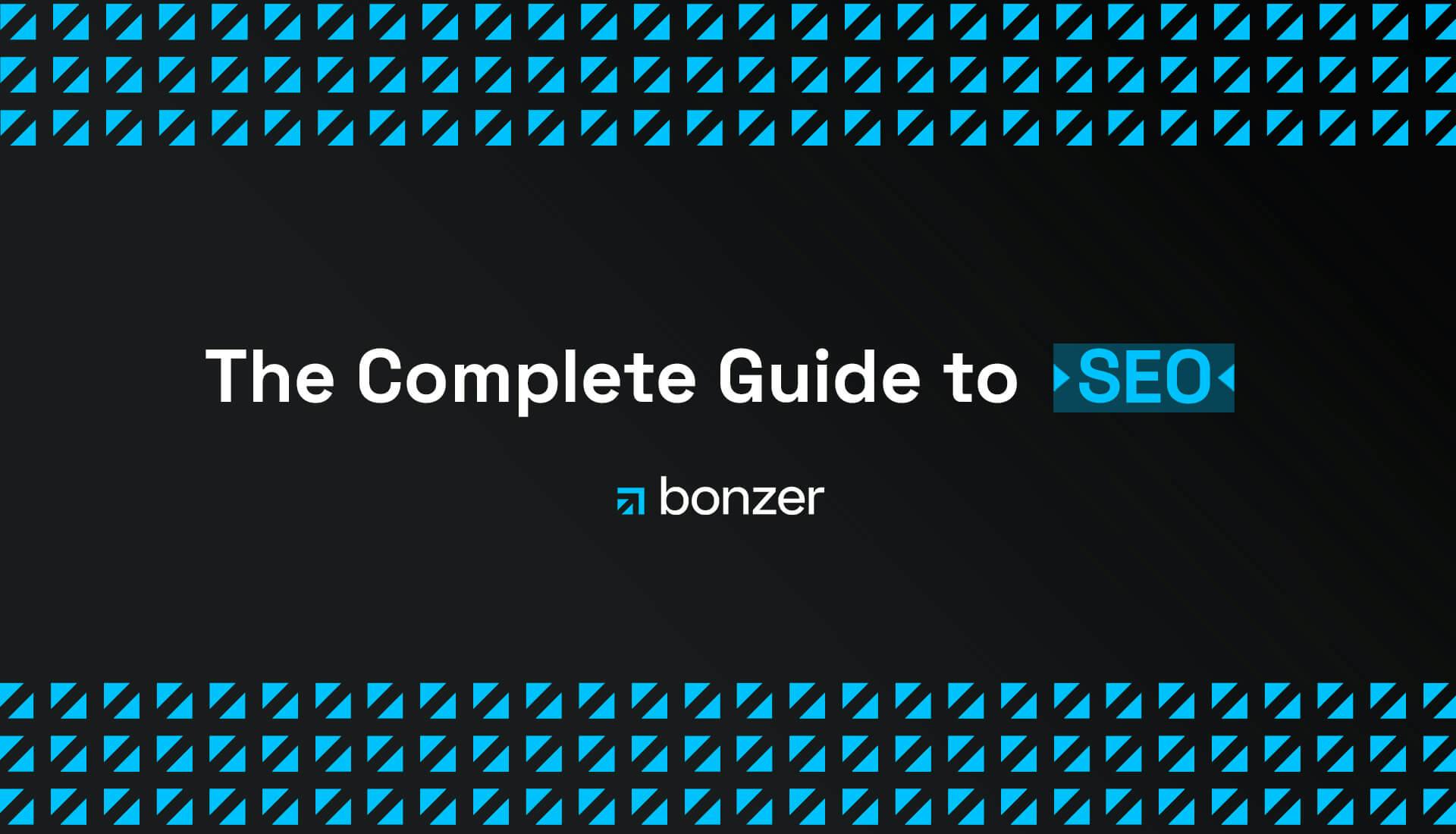
Poor structure and navigation
Low page speed
Duplicate pages without canonical tags
404 pages (broken pages)
Hreflang issues
Unnecessary redirects
Missing meta descriptions or page titles
Unnecessary use of crawl budget
Analysis / audits based on the three pillars; technical SEO, content and link building – based on the selected keywords
Make a performance plan for execution
Impact measurement on placements, traffic and conversions (and reporting if you work with customers)
On-going monitoring – use an analytics tool like Google Analytics or Search Console.
Business listings on Google My Business (helps people find you)
Know your target audience (address the right people the right way)
Know your competitors (keep your friends close; keep your enemies closer - some will always be ahead of you)
Know yourself (what do you have that no one else has?)
Follow the development (stay ahead of the development. That’s a corner stone in Bonzer: Making sure that our efforts and results aren’t wasted because they’re out-dated)
In this guide, you will learn what SEO is - and why it’s important for you and your business. We’ve gathered the most important areas of search and created this guide for you to apply to your own business.
We have therefore divided the areas into chapters in a step-by-step approach.
We'll always make sure to make ongoing updates, so you can be sure that this guide is always up to date with latest search trends.
What is SEO?
SEO stands for "Search Engine Optimization". When searching on Google (or any other search engine), you’ll see a list of results based on the phrases you’ve searched for. The search engine's algorithm then places the results in order of relevance and authority.
SEO can therefore help the search results advance to the top of the search engine: If you are among the top search results, you get most of the traffic. A landscape that is ever evolving.
This makes SEO a great online marketing tool: It makes you visible, creates growth, gives you more customers and is cheap to maintain. In other words, SEO is one of the forms of marketing that can provide the highest ROI.
How? It's all about time and will.
How traffic is distributed
According to Advanced Web Ranking, the first position in Google's organic results gets an average of 31,87% of traffic on desktop and 29,29% on mobile. Then the traffic drops for each search result you go down.
See below (latest figures from September 2021):
Without SEO, many pages will almost never see the light of day in Google's search engine. Google alone accounts for more than 92% of the total search engine traffic on the internet, so we primarily refer to Google when talking about SEO. Here, on average, 70-80% of traffic goes to organic search results.
Organic traffic means all traffic that isn’t paid for (ads). This makes SEO organic-only online marketing – meaning it’s free. As long as you know how to make best use of the Internet's many options.
So how does SEO work? There is not one answer.
SEO strategy can be approached in many different ways; it can be difficult to know where to start, and you can end up wasting a lot of energy. With this post, we’re sharing in-depth guidance on the essential pillars behind effective SEO.
Not everyone knows about SEO
A study by Fractl (2019), showed that 1 in 3 business owners were not familiar with working with SEO.
This means that 1 in 3 (based on the survey) is currently missing out on potential growth. And the potential growth is increasing: More and more people move online when seeking new knowledge or buying products.
Yet more than 70% of the respondents believed that SEO is either “moderate” or “very” important.
So let's take a look at the fundamental pillars behind Google's search results.
The three pillars of SEO
To rank among the top search results on Google, you need to beat your competitors in three disciplines: Technical SEO, Content and Link building.
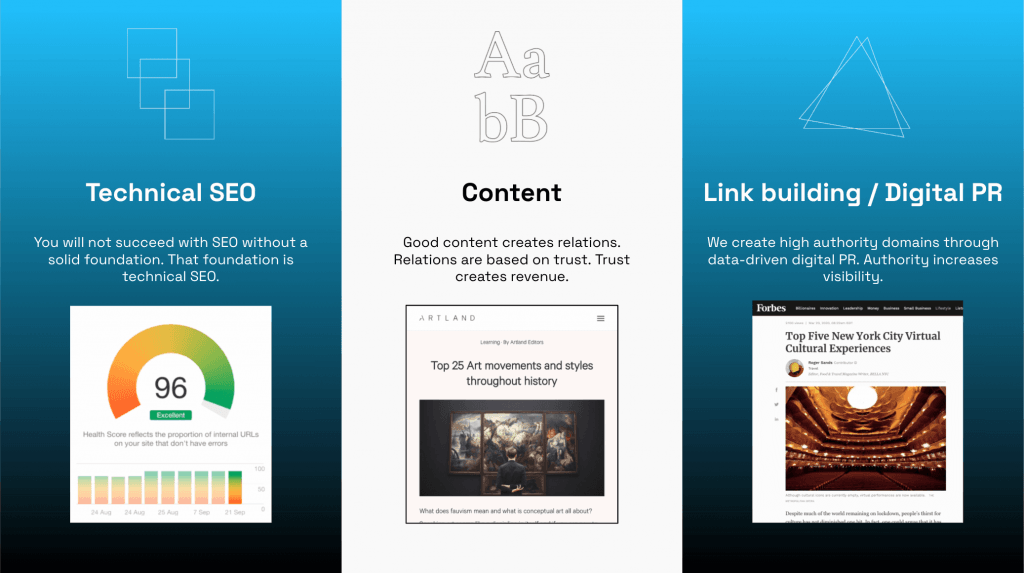
Some visualise this as a pyramid with keyword research included. However, we consider keyword analysis as part of content, because it involves the necessary analysis to be able to create targeted content.
Technical SEO
Technical SEO is the foundation of a website and the starting point for being found on Google. It’s categorized as ‘on-page SEO’.
Technical SEO covers everything technical from page structure to the user experience (UX), where design, structured data and page speed must be top notch – on both desktop and mobile.
The goal is ultimately to have a “Health Score” as close to 100% as possible, giving users the best possible experience - also expressed as user and page experience. A good structure also makes it easier for Google to find your content.
Here, the content you want to rank should be no further than 3-4 links from the front page.
Search Engine Land has created a pyramid of the technical hierarchy – read from top to bottom:
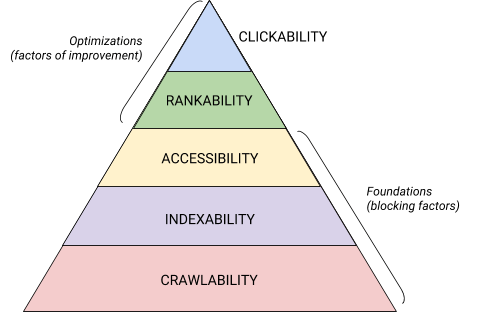
Content
Content is about disseminating your products in the best possible way through the content on your page. Content, therefore, also is categorized as ‘on-page SEO’.
Content includes both text and visual content such as images and video. Here, Google values interactive content higher than ever before.
To reach the top results on Google, you need to create the content that best meets your search intent. One of the most important things is that the content lives up to Google's rules about E-A-T. It stands for Expertise, Authority and Trustworthiness.
Working with a keyword, we need to make sure we deliver exactly what the users are looking for (their intention behind the search). Here, we need to look further into the search result page (the page that shows the results after you’ve hit enter on Google). That page is referred to as ‘SERP’ (Search Engine Result Pages).
By analyzing the result page, we can create unique content to meet search intent even better and gain as much space as possible in the SERP – this will increase CTR (Click Through Rate) and, thus, organic traffic.
This way, content will help you rank (higher) on the search engine.
Link building / Digital PR
Link building is based on the idea of creating authority for a page, which is best done with links. Link building is categorized as ‘off-page SEO’ because the links refer to other pages.
Consider links as virtual ‘likes’ or recommendations. The more likes you can get from relevant online authorities, the faster you rank - as long as your technical SEO and content live up to user requirements.
That’s why we refer to it as "Link building / Digital PR". It’s all about connecting your page to other pages with direct PR value. Here, quality is more important than quantity.
There’s good link building and bad link building. Google doesn’t like when pages try to cheat them with "fake" spam links or paid links from a Private Blog Network (PBN links).
That’s why we at Bonzer have developed what we call “The Triangle of Link Building”, which is based on the most important elements behind a good link; Relevance, Authority and Trustworthiness.
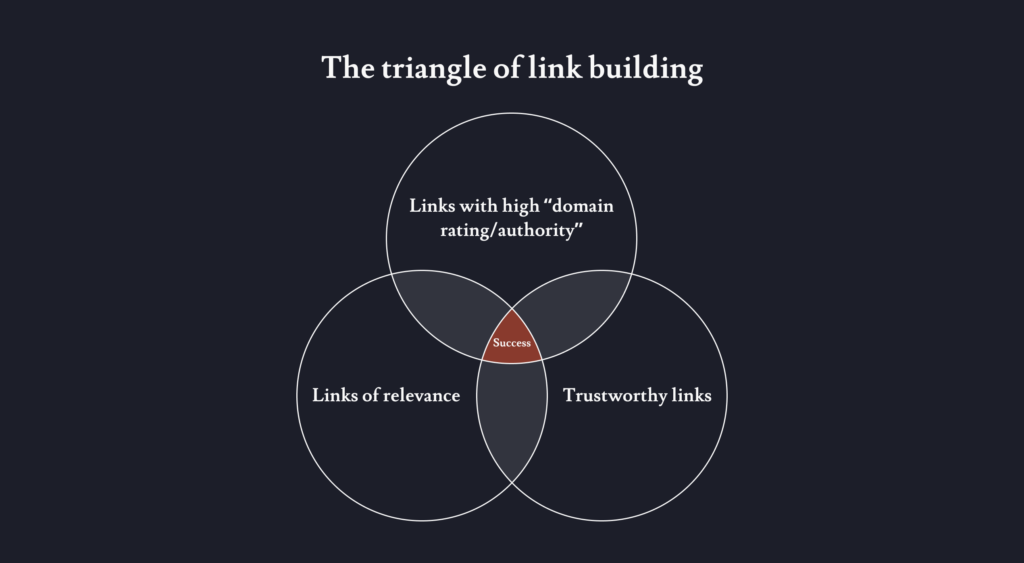
Before getting to the step-by-step guidance, we need to have the right mindset. And that mindset is also our best SEO advice.
Our best advice
Now, the obvious point here would be to say that SEO should be seen as a game and not a job. But we won’t be making that mistake - because that’s not always true.
What we will be giving you is a mindset. A mindset that will be your perfect starting point in getting started with SEO.
The most important thing to understand about SEO is SEARCH INTENT.
Users' search intent - that is, the intention behind each search - is the top 1 rule to follow. If you don’t deliver exactly what users are looking for, everything else you do won’t matter - because then you simply don’t rank.
If you start your SEO work with search intent, you are always at the forefront of the algorithm's updates. This applies to all industries.
Our remaining SEO tips may vary from one industry to another and may change over time. But search intent will always be important to follow. That’s our universal rule of thumb. Let’s not forget that one.
Your go to guide (step-by-step)
Let’s dive into the SEO steps to deepen your understanding of the areas you've been looking into so far.
These 10 chapters should be seen as concrete advice for you who want to know the way to a larger customer reach via SEO.
Each chapter leads to additional categories, which will then unfold as you go in depth with the subjects. That’s why we’ve created in-depth articles for each tip, so you can keep learning and perfecting you website.
We’ve also made a checklist that you can use as an overview of your entire SEO efforts. You’ll find that at the bottom of this guide. The checklist helps you keep an overview of the areas that you need to focus on in order to increase your presence on the search engine.
1. SEO is for people
Although SEO stands for "Search Engine Optimization", it actually mainly targets people – and not search engines. Because people search on Google - robots don’t. Therefor, we need to think in human terms when working with SEO. This subject is referred to as semantic SEO.
So what does it mean to think in human terms?
In order to rank well on Google search results, consider this: Do your users or customers find answers to the questions they’ve asked Google when they enter your website? This is completely essential for good SEO.
Find out what questions your page can answer, and then make sure to create content that does just that.
Many people focus on having as many keywords in content as possible. But, rather, we need to focus on giving users the most value possible.
Your page needs to be relevant and add value to the user - based on the keywords they searched for. That makes your page more valuable than the ones of your competitors. And that will give your page more traffic and, ultimately, make you stand stronger than your competitors.
2. Make your website a user experience
For your SEO work to be fruitful, we’ll move on to the second tip: It’s absolutely crucial that your website has an easy structure and good architecture.
In addition to that, your website must have modern technical features and cannot suffer from too many technical errors. And also, make sure that it’s mobile-optimized because Google is all about Mobile-First.
While these efforts may sound simple, this is exactly where websites typically fail.
Having several issues can challenge the user experience
Some of the most important issues for your website to avoid are:
The list is of course even longer and applies to both mobile and desktop. Here, the Google Search Console is a great tool because it sends regular reports on errors so you can keep your page user friendly.
In 2020, Google implemented the Core Web Vital report, which is based on the most important areas a website must live up to within “page experience”.

Following these is absolutely essential if you want to be synced with Google's guidelines. The better the technical foundation, the easier it is for search engines to find your page. This, of course, benefits the SEO work massively.
If your website doesn’t live up to these points, that’s one of the first things you should look into, as it affects the health of your site. This is referred to as your website’s Health Score.
Different SEO tools have different systems, but the Health Score typically values between 1-100, with 100 being the best result. If you have a Health Score of 100, in theory there are no technical problems on the site. For example:
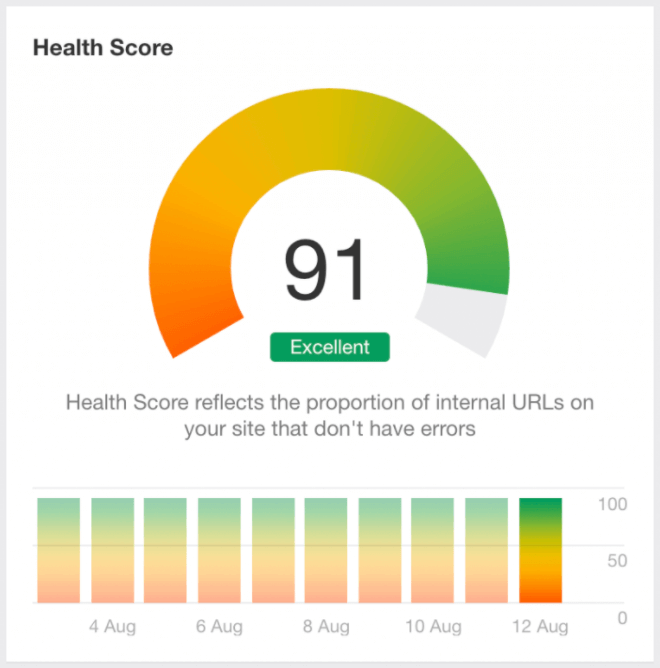
Again, if your website doesn’t have a solid foundation, that’s one of the first things to optimize. And that requires you to make the necessary demands from your website.
For example, you should expect your developer(s) to provide you with a website that lives up to Google’s Core Web Vitals and that generally follows Google's guidelines. Your website is your company's face to the world, and it’s crucial that it works as it should.
3. Make a sitemap
Do yourself a favour: Create a sitemap for your website. A sitemap forwards information about your website to the search engines, which makes it easier for them to find your content.
In short, a sitemap is a list of your pages that are indexed. If you need help creating a Sitemap, head over to Google and check out their Search Console Help.
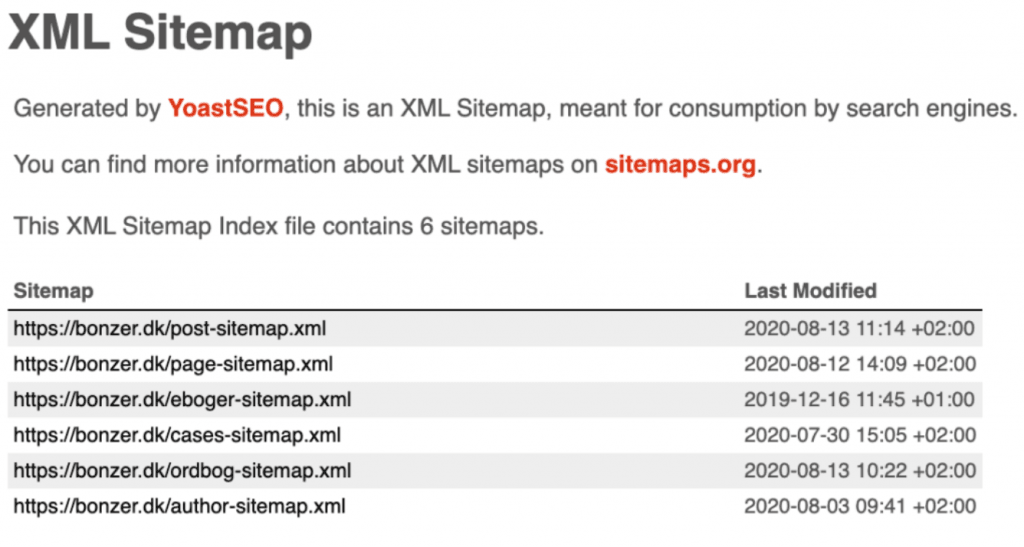
In the Google Search Console you can upload your Sitemap. It looks like this:
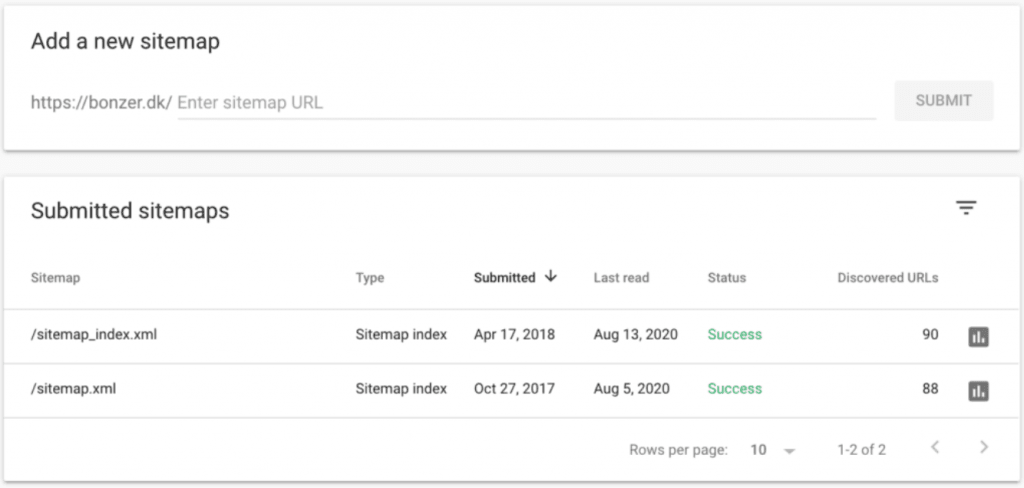
The easier it is for search engines to find your page, the more likely your page is to appear faster and rank higher in the search results.
4. Choose the right keywords with a keyword analysis
Keywords make up a huge part of SEO. ‘Keywords’ is a term for what people search for in the search engines, and they are what your page should rank on in the search engines.
So if you run a pizza business in New York and you want to be found easily by the search engines, you should choose keywords that people who order pizza and live in the New York area would search for. In this case, the obvious choice would be a keyword phrase like "pizza new york".
As the following graph shows, the search “pizza new york” has:
- A monthly search volume of 1,200
- A keyword difficulty on 42 out of 100
- A cost-per-click (CPC) of $3.00
Notice, in the graph, there are also 528 clicks on the search results. This indicates that less than one search results are being clicked on (probably because of local Google search results).

All these numbers are factors that come into play in an overall keyword analysis.
Make sure that the keyword you choose is reflected in the content on your page - and make sure you live up to the search intent.
We suggest you spend some time optimizing your keyword, as well as relevant related searches (longtails), so that you live up to everything in line with the search.
Finding the perfect keywords can be difficult, but with a thorough keyword analysis, you can find some really attractive searches. Searches that (together with targeted SEO) can make you rank higher in the search engines. This, however, requires that you know your target audience and their needs.
5. Create relevant and good content
Sometimes, people who want to optimize their website think that they need to write as much text as possible. But with good SEO it’s quality over quantity. We you’re your website to live up to Google's E-A-T guidelines and deliver what users want to find.
Earlier, with simpler algorithms, you just needed to repeat a keyword as many times as possible in your content (‘keyword stuffing’). Today, you need to deliver content naturally - of course still using keywords, so Google knows what the page is about.
Make sure that the content on your page matches the intent behind the keywords being searched for. And make sure it matches your target audience.
The most important thing about your content is that it answers the questions behind each selected search - and don’t be shy, show your expertise. This content can be text or visual content – anything that connects with your target audience.
Content is all of the content on your page
When it comes to optimizing the content that you have on your page, it’s essential that you look at everything: It's everything from headline to footer. This means that you categorise the headlines based on H1, H2, H3 tags, etc. This is also called headings. Make sure to put all of the important keywords in H1 (heading) and H2s (subheadings).
Check the source code on your website to make sure you have set them up correctly:

In addition, remember to look into the use of images and make sure that they all have relevant ALT text. That shows the search engines what your images are about.
The use of video content is increasing – and with good reason: We tend to value information provided through video higher than text and images. Therefore, consider if you can deliver your messages through video content on your various landing pages.
Overall, it’s a good idea to make your content as captivating and easily consumable as possible for the users to easily understand your message.
Your content must be relevant to the user and have a common thread between them. Here, the keyword analysis is essential to get done to find out which words are searched for the most within your area.
This allows Google to link your content on your page to individual searches. With good and relevant content on your pages, Google will be able to see the value that your content provides, and that gives you better chances of a higher ranking in the search results.
And this leads to more traffic.
Get inspired by the competitors
Here’s an easy way to get inspiration for your page's content: Check out the pages that are currently ranking at the top of Google on your selected keywords. Yep, those are your competitors.
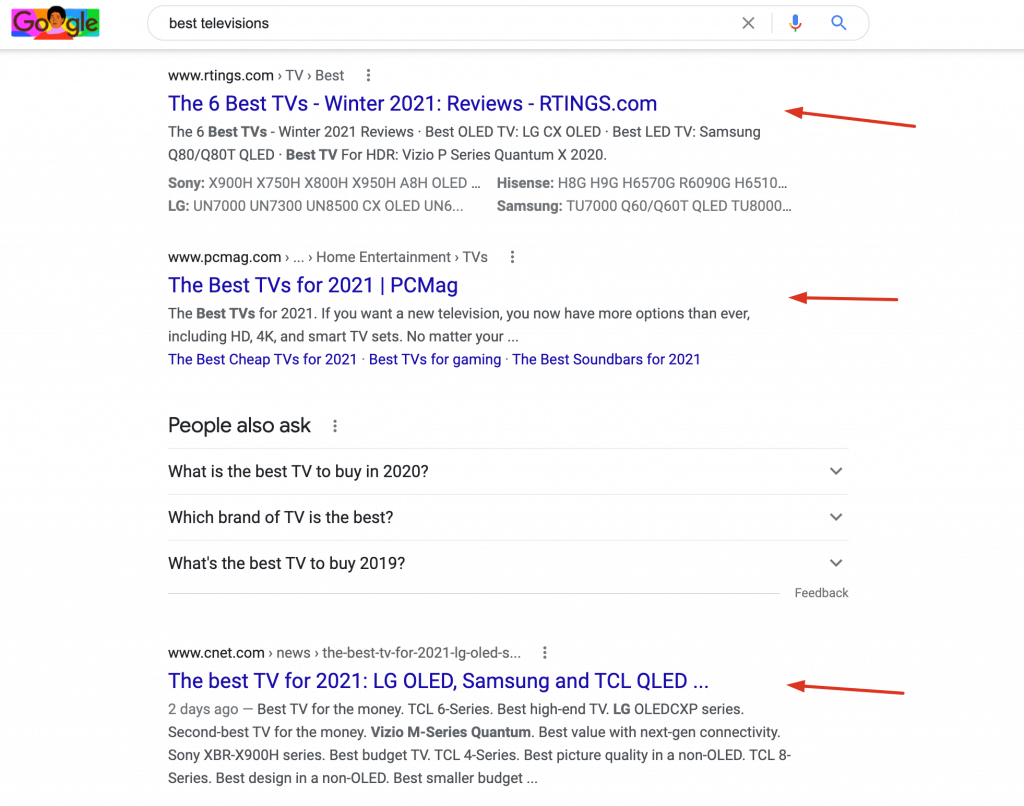
Find out what they do well. Learning from that and implementing it on your website is how yours can outperform theirs.
6. Take action – Here’s what counts
OK, your website has been taken technically up-to-date. Relevant and sharp content has been created. It’s time to look at how you can motivate your customers to take action. Call-To-Actions need to be created in order to lead people towards a desired action.
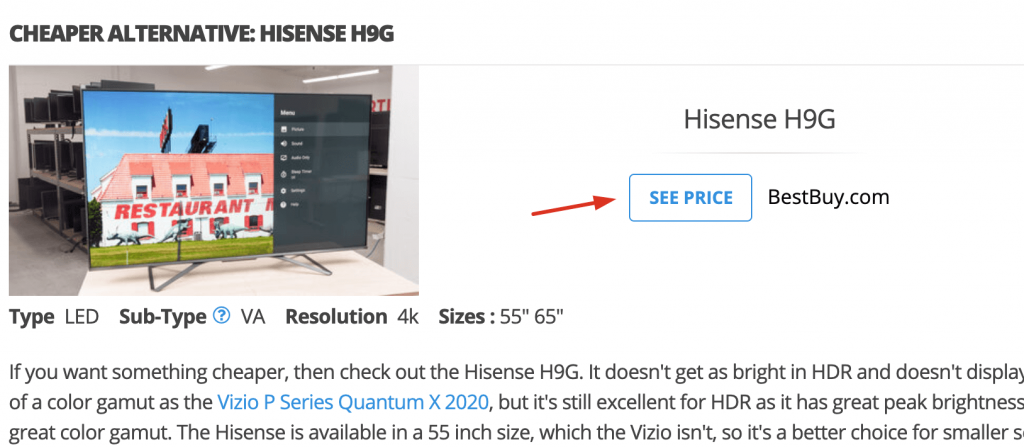
Your website has a purpose, and we need to engage users to follow that. Whether the desired action is a purchase or signing up for a service, they need to be guided through the user journey from start to finish, so that they find it completely natural to take the last step: The desired action.
When it comes to keeping track of how users behave on your pages and how they act, Google Analytics is a great tool - take advantage of that. With Google Analytics you can analyse several parameters in the users' actions on your page(s).
Various parameters worth observing
One of the parameters you should keep an eye out with is Bounce Rate. Bounce Rate tells you the percentage of your visitors that leave without interaction. That way, you know how many only visit one page, and then exit again immediately.
You want to engage users to stay on your page so that they not only visit one page, but check out several of your pages or do something active in there. The more of your subpages users access, the more engaged they seem.
That makes the parameter ‘Time on Page’ super important. That’s what shows the time people spend on the selected page. The longer they spend on that page, the more engaged they are in the content.
Obviously, conversions are crucial - often that’s ultimately the goal. How many of the users actually sign up for your newsletter, fill out the various forms or end up buying something on your page? The more conversions, the more successful your SEO is.
This underlines the importance of a good user experience – and content is everything here. And that’s why content and technical SEO are related.
7. Page titles and meta descriptions should catch attention
Before users can even click on your page, they must evaluate which page on Google's search results fits their needs the best. Therefore, it’s essential that your page titles and meta descriptions are sharp - so that they choose your website over the others.
Page titles and meta descriptions are the absolute first-hand impression that users get of your website. In addition, they also play a huge role in relation to CTR (Click Through Rate) - that is, how many people choose to click on your results over others. Google is happy with a high CTR on their SERP. Overall, a good CTR will make you and your website rank higher in search results.
When a keyword is typed in the search engine, a number of results will appear. The text associated with each page in Google's search results is the page title and meta description.
Page title

A good page title is important if you want people to choose your website (although it doesn’t directly affect the ranking). You choose what your page title looks like, but there are a few tricks:
First, make sure your page title contains your primary keyword - the most important keyword of that page. This allows users to easily identify their search with your result.
So, that before writing title descriptions for your page, make sure you know which keyword you want the page to rank on.
Also, a good page title is neither too short nor too long. Google can display a maximum of 512 pixels of the page title. That means that part of your text will be cropped in Google search results if you make your page title too long.
Meta description

Meta descriptions also have no direct impact on your ranking in the search engine results. But that doesn’t mean it’s not important. The meta description will appear below your page title, and there users / customers will also read the meta description when considering visiting your page – just like the page title.
Here’s another reason a good meta text is important: If Google doesn’t get a meta text from you, it automatically adds text from your page. That may be irrelevant to the page title, and less people will click.
The best meta description contains about 150 characters (max. 160). Here, as with the page title, it’s also a good idea to include the most important keyword. This part is written in bold in your meta description, and that makes it catch attention.
So, it’s important for a good page title and meta description be tailored for each individual page, so they match the keywords and the content found on the pages. Remember, it’s all about selling the page – people need to be drawn towards it. Because the better the CTR, the more traffic you get.
8. Use links to connect with your surroundings
Link building is one of the most fundamental and popular ways to rank higher in the search engines. Why? Because it provides authority. But there are many ways to build links. Here are some good and bad ways to do it.
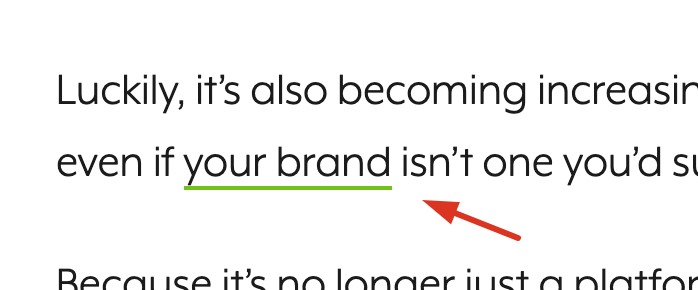
Link building is, as previously described, when a page links to a different website. In your case, it means when other websites link back to yours. That’s why it’s also referred to as "backlinks". It’s a way to get your website recommended over others.
The analysis tool Ahrefs has made an overview of the correlation between the amount of links that point to a domain with the development in organic traffic. The context shows the clear influence that links have on traffic:
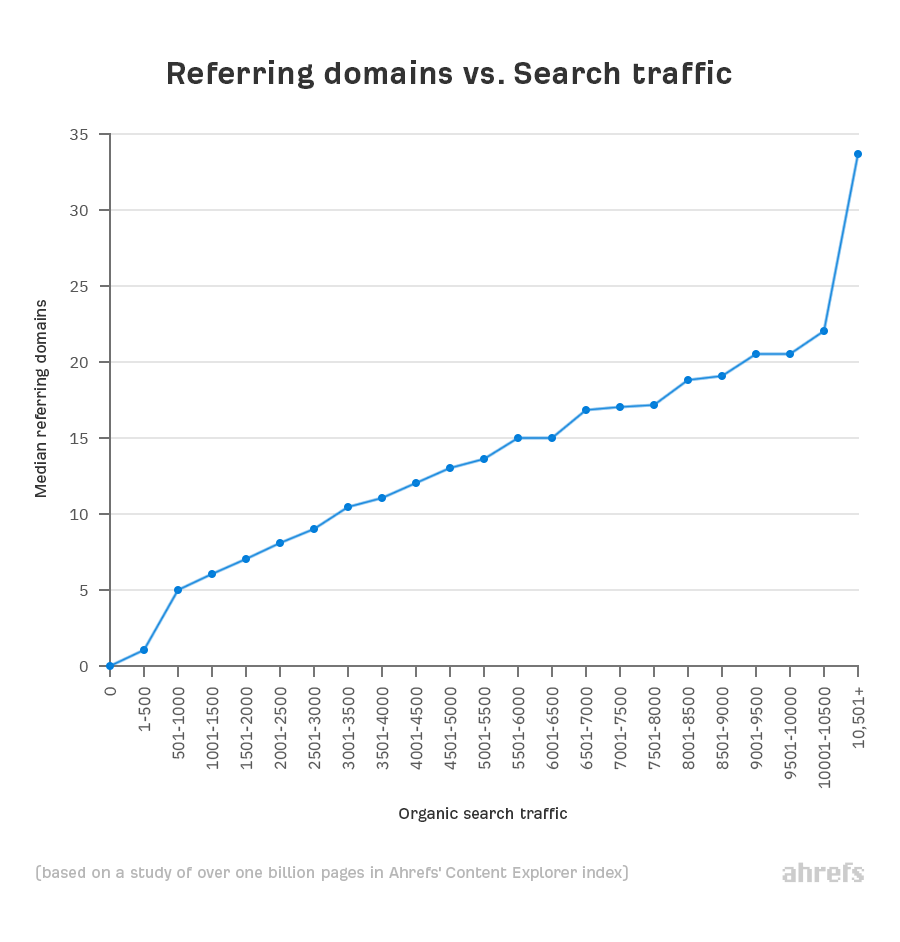
But there’s good and bad link building. So, let’s look into what separates the two so you can get the best out of your investment.
What is good link building?
Good link building is when you create relevant and useful content (an article or study for example); then promote it to relevant media that then share it using a link that goes back to you - in a relevant context.
The link itself can be in the middle of the article, so it’s part of the text. This is referred to as anchor text.
The best link building is done with links from pages with high traffic and authority. Preferably websites that are relevant and add value to your own page (and follow The Triangle of Link building).
Some say that link building is becoming irrelevant as a tool for ranking, but that’s far from true. You just need to work it in clever ways.
What is bad link building?
If your link building becomes too advertising-oriented, Google may start seeing it as spam - and you’ll lose your rankings. Therefore, make sure to follow Google's guidelines.
If there are too many links on a page, the importance of each link will lose value. So make sure to go for links from websites that also live up to Google’s guidelines – unlike Private Blog Networks (PBN).
Private Blog Networks are domains that are built to link to each other. Usually, there’s not much relevance in the content, and these links can usually be bought. This is against Google's guidelines.
So, remember: The idea of link building isn’t to get endless links - but links from quality domains. It’s the quality of the links that makes your page stronger and gives you higher rankings.
Outbound links
Backlinks are great. But there’s also value in you linking to external websites.
That’s because you want to associate yourself with other powerful sources that help people move forward in the search phase. Search engines like that.
Internal links
Lastly, internal link building (links between your pages) is also important. That’s a great way to keep your pages connected. That means that your subpages must refer and link to each other – that adds value. This is referred to as pillars and clusters; it’s a model of the structure behind a user-friendly site.
So, try to get strong and relevant websites to link to yours – in a way that is natural and relevant. That way, you’re making sure you’re getting the most out of your link building.
9. Make use of social media
A great thing about SEO is that there are no limits when it comes to optimizing. It's all about being creative!
SEO is about online optimization. And it’s a good idea to be present where many people spend their time and where you can be creative in your online marketing. That makes social medias a great tool.
By getting SEO and social media platforms to work together, you increase your chances of reaching more people and engaging a larger audience. That, in return, can help bring more traffic to your website. If a post goes viral, you increase the chances of getting links from more websites.
Therefore, always make your content shareable through the SoMe channels.

Using social media wisely can increase your conversions significantly.
Know the platforms when connecting SEO and SoMe
From a SEO perspective, it’s not enough to just create a profile on Facebook, Twitter, Instagram, Pinterest etc.
You need to actively use each platform in the best way possible and utilize the opportunities on there. Find out how people use the platform and, then, engage the users with your content.
For example, you could make some fun or interesting posts on Facebook - or contests that followers can participate in. Or a Pinterest profile where you share photos your work day with the world.
The possibilities are many; it's all about being creative and reaching as far out to your target audience as possible. Find the media that works best, get to know them and get your target audience engaged in what you do. That way, you get SEO and social media to create a strong synergy. A synergy that provides insight into your target audience so you understand what is important to them here and now.
10. Follow SEO ethics and you will be rewarded
Following the SEO ethics basically means that you follow Google's guidelines in search engine optimization. Several of the points have already been mentioned in this post. But the importance of following Google's guidelines cannot be stressed too much: You’ll be punished if you don’t follow them –that means being pushed back in the search results.
Basically, you need to create websites that are targeted at people and not search engines – no big surprise. But it’s easy to become so technical in the SEO work that you completely forget that your users are people and customers - not search engines.
Do not try to trick Google into making your page rank higher. This is referred to as "black hat SEO". It will do more harm than good in the long run.
Also, avoid creating profiles on pages that are only meant to link to each other. If they have no real relevance to your own website, Google won’t see it as a positive thing.
Likewise, we strongly recommend to stay away from purchased links.
Having multiple pages is fine, but make sure you don’t have the same content in several places. If you have duplicated content on too many pages, it confuses the search engines, and that means: Bad SEO.
Lastly, we suggest you to make everything you do on your pages as natural as possible. So, do your SEO well, but don’t make it look like SEO.
The whole experience on your website should be as natural as possible for the customers so that the user experience becomes a success. That will make customers come back and you’ll see your conversions increase.
When will I see results?
The obvious question is, of course: "How fast can I rank on page 1?"
In the world of search engines, however, the obvious answer is “it depends …”.
It depends on the strength of your page. The difference between a new page with no links compared to an established website with links will also determine the average time it takes to rank at the top.
An analysis conducted by Ahrefs shows that takes an average of +2 years to reach page 1 of Google:
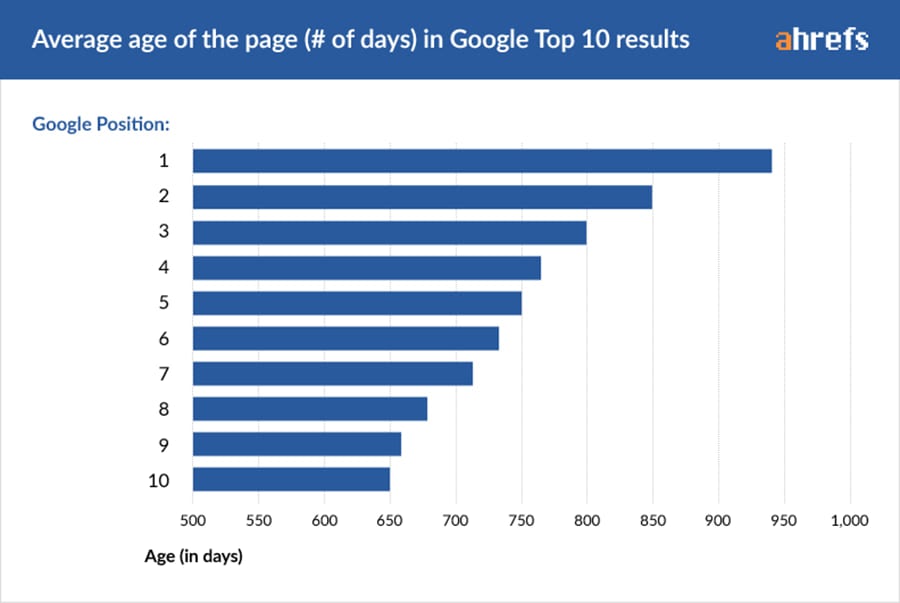
In the study, a selection of 2 million keywords was chosen. And only 22% of the search results had content created within the past year.
That’s because Google needs to index the content. And after this, a lot of work follows – link building in particular. However, if you work intentionally with SEO, the results can show up faster.
So, with the right initiatives, you can easily succeed. And this way, your business will experience growth in the long run.
Google algorithm updates
As we humans constantly develop our needs and requirements for technology, search engines, including Google, obviously need to keep up. Therefore, Google updates their algorithms several times a year.
The goal of each update is to give the many users on Google even better answers to their searches and to present search results in the best possible way.
Previously, Google's search results consisted primarily of the classic organic search results (also called "web page listing" or "blue link listing").
Today, Google's Search Engine Result Pages (SERP) consist of significantly more information and results:

One of the really big updates came by the end of 2019; the update was called BERT. BERT made Google understand searches even better, and that all affects the Google SERP and the results displayed.
The Google we know today is made up of all the different updates throughout time. Check out this timeline to get the full overview of the previous Google updates.
A final piece of advice
The Internet is virtually infinite, and people spend more and more time online every day. Therefore, the possibilities with SEO are also unlimited, and it's all about exploring for yourself.
With these 10 tips, you are now ready to start working with SEO. But take one step at a time - each part is a chapter of its own.
It can be overwhelming to throw yourself into everything at once, if you’re new to it. But do use it; there are huge opportunities there for you and your business.
So, is SEO difficult? It doesn’t have to be. Not if you make use of the available online tools in the best possible way - and with these tips you're well on your way.
Don’t lose your motivation if you don’t see results right away. SEO is organic; it takes time before things starts to move. That’s what makes it a great long-term investment: It’s not an investment in ranking #1 here and now; it’s an investment in ranking #1 for all time to come.
“The best marketing does not feel like marketing.”
- Tom Fishburne
Keep track of your future SEO work tasks
As you can see, there are many initiatives when it comes to SEO - and it’s constantly evolving. Therefore, we recommend that you make a game plan. This should include:
To give you the best toolbox, we have made a SEO checklist based on the 10 chapters.
Each item is under the category, Technical SEO, Content or Linkbuilding.
Stabilising digital growth in uncertain times
The global situation has forced us to get familiar with change even more than before. In SEO, change is a on-going theme, because the landscape of the search engines is ever-changing.
Search engines like Google continuously update and improve their algorithms towards the users. Therefore, make sure to stay updated from Google and keep yourself and your website up-to-date on the most important ranking factors.
Make sure to check these:
If you have any questions, comments or requests for analysis, feel free to reach out to me directly at [email protected] or apply for an analysis with us here.
SEO FAQ
Below you will find answers to some of the most common SEO questions.

CPO & Partner
Thomas is the CPO (Chief Product Officer) and Partner at Bonzer, which means his day-to-day focus lies in constantly analyzing Google's algorithm and developing SEO as a product. Thomas has worked with SEO for several years with a strong passion for sharing his knowledge on how businesses can best implement SEO into their operations. In addition to Bonzer, Thomas contributes his expertise to readers at publications like Search Engine Journal, DanDomain, and Detailfolk. He also teaches Digital Media Strategy at Copenhagen Business School and SEO at DMJX in Copenhagen. If you have any questions or requests regarding the SEO universe, feel free to contact him at [email protected].

Let us show you an SEO strategy that can take you to the next level
A brief meeting, where we review your position in the market and present the opportunities.
Let us show you an SEO strategy that can take you to the next level
A brief meeting, where we review your position in the market and present the opportunities.